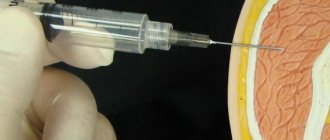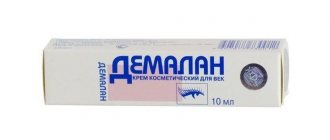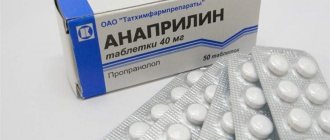pharmachologic effect
Solutan is a combination drug that acts on the body as an antispasmodic, expectorant, bronchodilator, and anticholinergic agent.
Used for the treatment of bronchitis, as well as bronchial asthma .
The medicine contains ephedrine hydrochloride, which provides a bronchodilator effect, which leads to dilation of the bronchi. Also, under the influence of this remedy, the patient’s breathing improves and blood flow is activated. As a result, asthma attacks are alleviated.
One of the components of this drug is an alkaloid from horsetail ephedra. This component provokes the appearance of strong excitation in the central nervous system, therefore it is classified as a narcotic. Therefore, it should be taken into account when taking Solutan that this drug has such an effect on the body.
Release form and composition
Solutan is a combination drug used to treat bronchial asthma and bronchitis. The drug has expectorant and bronchodilator properties, which helps to dilate the bronchi and remove mucus.
The pharmacological product is available in the form of drops for oral use. Solutan drops are sold in 50 ml plastic or glass containers. For ease of use, the bottles are equipped with a dropper attachment.
The medicinal solution contains:
- Ephedrine hydrochloride. A mild, non-addictive drug that promotes dilation of the bronchi.
- Procaine hydrochloride. An anesthetic that reduces spasms of the muscular structure of the bronchi. A high concentration of the element represents a drug.
- Sodium iodide. Regulates healthy pH levels in the bronchi, preventing complications from exposure to pathogens.
- Tolu balsam extract. Promotes the regeneration of the affected tissue structure of the bronchi.
- Almond water. Creates the required consistency of the solution.
- Dill oil. Affects the dilution of bronchial and alveolar mucus.
- Saponins and radobelin. Additional ingredients.
The drug is a secretolytic that stimulates the motor function of the bronchial tree and has an expectorant effect.
It is recommended to store the medicine in a dark room at a temperature not exceeding 25 degrees. The period of application is limited to three years.
Ephedrine hydrochloride as a drug
Ephedrine is one of the four active constituents of the ephedra plant, which grows in the highlands of Siberia and Asia. The element is a poisonous psychostimulant of natural origin.
The concentration of this substance in pharmacological products should not exceed 10%. The compound is similar in its effect on body systems to methamphetamine and amphetamine - irritants of the central nervous system.
In medicine, the substance is approved for use as ephedrine hydrochloride for the treatment of bronchopulmonary pathologies, the consequences of intoxication, and allergies. The ability of the substance to constrict blood vessels makes it possible to treat rhinitis and sinusitis. The stimulating effect on the nervous system allows you to get rid of asthma attacks.
Side effects
During treatment with Solutan, the following side effects may occur:
- Digestive system: nausea, dry mouth, pain in the epigastrium, diarrhea, vomiting.
- Central nervous system: heavy sweating , migraines , sleep problems , anxiety, dilated pupils.
- Cardiovascular system: ataxia , heart pain, increased blood pressure, tachycardia , arrhythmia .
- Allergic manifestations.
Side effects increase with overdose.
Instructions for use PROTAMIN-INSULIN HS (PROTAMIN-INSULIN HS)
During insulin therapy, constant monitoring of blood glucose levels is necessary.
In addition to insulin overdose, causes of hypoglycemia may include:
- replacing the drug, skipping meals, vomiting, diarrhea, physical stress, diseases that reduce the need for insulin (impaired liver and kidney function, hypofunction of the adrenal cortex, pituitary gland or thyroid gland), changing the injection site, as well as interactions with other drugs.
Incorrect dosing or interruptions in insulin administration, especially in patients with type 1 diabetes, can lead to hyperglycemia. Typically, the first symptoms of hyperglycemia develop gradually, over several hours or days. They include the appearance of thirst, increased urination, nausea, vomiting, dizziness, redness and dryness of the skin, dry mouth, loss of appetite, and the smell of acetone in the exhaled air. If left untreated, hyperglycemia in type 1 diabetes can lead to life-threatening diabetic ketoacidosis.
The dose of insulin must be adjusted in cases of thyroid dysfunction, Addison's disease, hypopituitarism, impaired liver and kidney function, and diabetes mellitus in elderly patients over 65 years of age.
Concomitant diseases, especially infections and conditions accompanied by fever, increase the need for insulin.
Insulin dosage adjustments may also be necessary if the patient increases their level of physical activity or changes their usual diet.
Switching from one type or brand of insulin to another should be done under the strict supervision of a physician. Changes in concentration, trade name (manufacturer), type (short-acting, intermediate-acting and long-acting insulin, etc.), form (human, animal origin) and/or method of manufacture (animal origin or genetically engineered) may require adjustment dose of insulin administered. This need to adjust the insulin dose may occur both after the first use and during the first few weeks or months.
When switching from insulin of animal origin to Protamine-insulin ChS, some patients noted a change or weakening of symptoms that were precursors of hypoglycemia.
In cases of good compensation of carbohydrate metabolism, for example, due to intensified insulin therapy, the usual symptoms that are precursors of hypoglycemia may also change, about which patients should be warned.
Cases of heart failure have been reported with the concomitant use of insulin and thiazolidinediones, especially in patients with risk factors for heart failure. This should be kept in mind when prescribing this combination.
If the above combination is prescribed, it is necessary to promptly identify signs and symptoms of heart failure, weight gain, and edema. Pioglitazone should be discontinued if cardiovascular symptoms worsen.
Impact on the ability to drive vehicles and operate machinery
Patients' ability to concentrate and reaction speed may be impaired during hypoglycemia and hyperglycemia, which can pose a danger, for example, when driving or operating machinery. Patients should be advised to take measures to prevent the development of hypoglycemia and hyperglycemia when driving a car and working with machinery. This is especially important for patients with no or decreased severity of symptoms that are warning signs of developing hypoglycemia or who suffer from frequent episodes of hypoglycemia. In such cases, the advisability of driving should be considered.
Instructions for use of Solutan (Method and dosage)
Instructions for use of Solutan include taking the drug orally immediately after meals. A single dose of the drug is 10-30 drops; the drug should be taken 2-3 times per day.
If the patient experiences asthma attacks, the single dose of Solutan can be increased to 60 drops.
Children should take 5-10 drops 2-3 times a day. It is also possible to use the product by inhalation: vapors of the solution must be exhaled through the upper respiratory tract.
You can do such procedures using a pocket inhaler. From 10 to 30 drops are used per inhalation.
Precautionary measures
The drug Solutan contains a substance that, due to its strong stimulating effect on the Central nervous system, is equated to a narcotic, and although its content is not so high, the solution can be bought in a pharmacy only with a prescription.
You should strictly follow the dosage prescribed by your doctor to avoid side effects.
In addition, with long-term use, addiction occurs, the effect decreases and the dose has to be increased.
Solutan should not be taken in combination with alcohol.
When taking medication, you need to be careful when driving, as it contains alcohol and substances that reduce alertness and affect vision and heart muscle (side effects).
There is no information about interactions with other drugs.
Analogs
Level 4 ATC code matches: Cashnol
Anise oil
Bronchophyte
Pine buds
Pertussin
Bronchosan
Gedelix
Mixture for inhalation
Herbion ivy syrup
Herbion plantain syrup
Herbion primrose syrup
Mukaltin
Sinupret Forte
Dr. Theiss syrup with plantain
Bronchosept
Joset
Thermopsol
Tussamag
Marshmallow syrup
Dry cough syrup
Wikipedia testifies that there are no analogues of this drug for the active substance.
As analogues of Solutan, medications that contain ephedrine hydrochloride .
Composition of the drug Solutan
The solution contains valuable substances in 50 ml:
- ephedrine hydrochloride - 87.7 mg - the substance is obtained from belladonna root - the main active ingredient has bronchodilator properties, increases the lumen in the bronchioles, normalizes the respiratory rhythm, activates blood circulation in the respiratory system, relieves asthma attacks, makes breathing freer;
- Radobelin 5 mg, and Saponin Gipsophillae 50 mg, relax smooth muscles;
- fennel oil 20 g restores nerves, thins mucus accumulating in the bronchi and alveoli.
- novocaine hydrochloride 200 mg – is the main anesthetic component, relieves spasms and pain in the bronchi;
- sodium iodide, 500 mg – has an antimicrobial effect, ensuring normal pH of bronchial mucus;
- Tolu balsam extract (1250 mg) - the substance heals cells and restores bronchi;
- bitter almond water – 1500 mg g helps to give the preparation thickness and has an anesthetic effect.
The auxiliary components are purified water and ethyl alcohol.
The drug can sometimes precipitate, there is nothing to worry about, as long as it is suitable. You just need to shake the contents.








